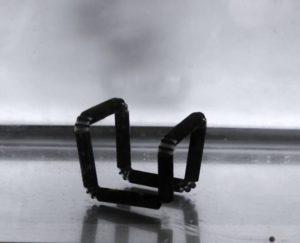We all know what 3D printing is – obviously. (If you don’t, here’s a handy overview. Welcome, newcomer.) We’ve also explored 4D printing, which involves printed objects that mutate and morph into different shapes when exposed to an outside stimulus such as light, water or temperature changes. So what’s involved in 5D printing? Printed objects that levitate? Printed objects that teleport? Time-traveling printed objects?!
Well…no. You can 3D print a TARDIS, but you still can’t make it travel. 5D printing is simply another name for five-axis additive manufacturing, and while it may not be as exciting as teleportation, it’s still pretty cool – and useful. The term “5D” as applied to five-axis printing is being used by Mitsubishi Electric Research Laboratories (MERL), the North American subsidiary of the multinational corporation’s research and development branch. They’ve been experimenting with a print bed that actually rocks back and forth on two axes, creating a fourth and fifth axis as a result.
“It’s the same shape, made from the same CAD model, made out of the same plastic from the same spool, made on the same machine,” he says. “But the 5D printed part is up to five times stronger. That’s like the difference between a bicycle and a racing motorcycle.”
To prove his point, Yerazunis and a colleague printed the same pressure cap in both 3D and 5D, then tested them by adding pressure. The 3D printed cap pitifully burst after about a second, making it only to 0.1 megapascal of pressure before it decided it had had enough. The 5D printed cap, on the other hand, held on for the application of 3.7 megapascals before blowing its top.
It’s a very different approach to additive manufacturing, and goes to show that the limits of 3D printing are never really set in stone. The process can always be toyed with and altered, sometimes to surprising – and exciting – ends. Many manufacturers may find MERL’s study to be of great interest, especially manufacturers who have held off using 3D printing for end use parts because of insufficient material strength.
“Our goal in this 5D printing project is to make parts that are strong in the directions they need to be strong in, no matter what direction that happens to be….5D printing does require a lot of analysis, and it does require knowing how the part will be used,” says Yerazunis. “But when you can make a part that’s five times stronger, that really changes how you think about 3D printed parts.”
You can watch the experiment for yourself below, and discuss the topic further over in the 5D Printing forum at 3DPB.com.
